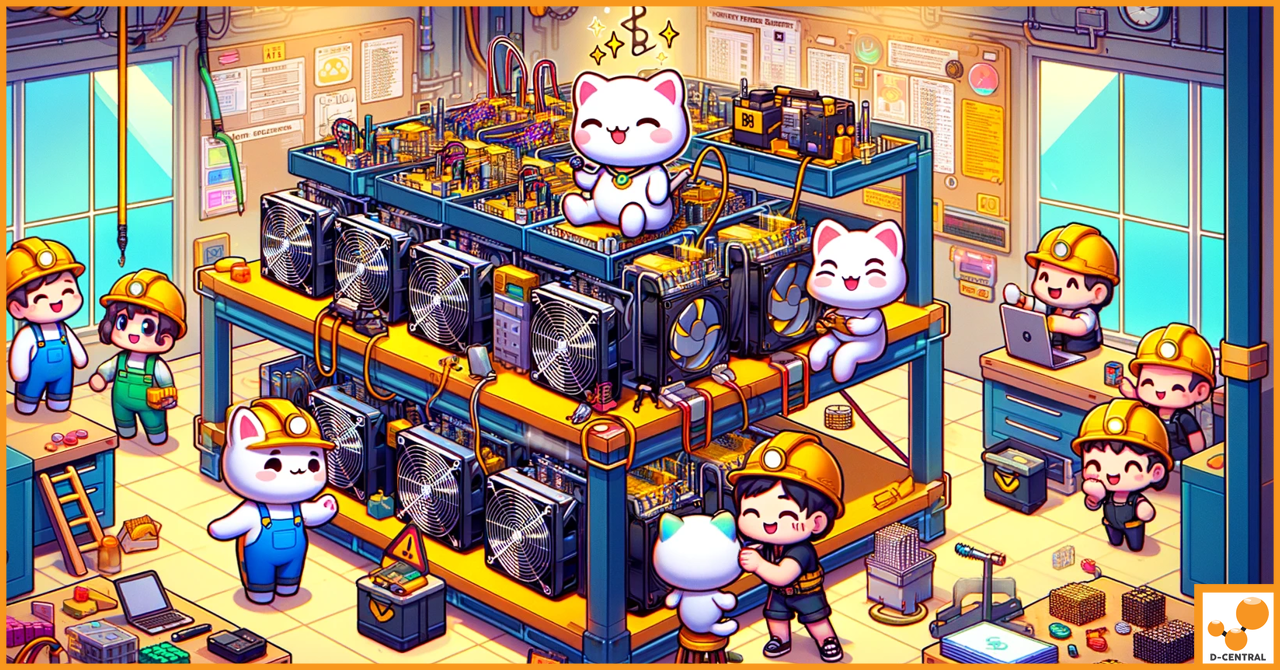
Comprehensive Bitcoin Mining Hardware: Your One-Stop Shop for ASIC Miners and PSUs
Welcome to the world of Bitcoin mining! Whether you’re a seasoned miner or just starting your journey, D-Central Technologies is
4479 Desserte Nord Autoroute 440, Laval, QC H7P 6E2

In the fast-paced world of cryptocurrency mining, maintaining the peak performance of your mining rigs is not just beneficial—it’s essential. Antminer rigs, renowned for their efficiency and power in the crypto mining industry, are no exception to this rule. Regular maintenance of these sophisticated pieces of hardware is crucial for several compelling reasons.
First and foremost, the continuous operation of Antminer rigs, often in demanding conditions, subjects them to wear and tear that can significantly impact their performance and longevity. Just like any high-performance machinery, these rigs require periodic check-ups and tune-ups to ensure they operate at their best. Neglecting maintenance can lead to decreased hashing power, increased power consumption, and, in the worst-case scenario, complete system failures that can halt your mining operations and lead to costly repairs or replacements.
Moreover, the efficiency of your mining operations is directly tied to the health of your Antminer rigs. Regular maintenance ensures that each component of the rig, from the cooling fans to the hash boards, functions optimally. This not only maximizes the hash rate, ensuring a higher probability of mining success but also optimizes energy consumption, which can significantly affect profitability in an industry where margins can be thin.
In essence, the regular maintenance of Antminer rigs is not just a routine chore; it’s a strategic investment. It safeguards your hardware investment, maximizes operational efficiency, and ensures the longevity of your mining rigs, thereby securing the foundation of your mining endeavors. In the following sections, we’ll delve into the essential maintenance tasks that every Antminer rig owner should perform to achieve these goals, ensuring that your mining operations continue to thrive in the competitive landscape of cryptocurrency mining.
Antminer rigs, developed by Bitmain, stand at the forefront of cryptocurrency mining technology. Known for their robust performance and reliability, these rigs have become a staple in the mining community. To effectively maintain and optimize your Antminer rig, it’s crucial to understand the various models available and their specific characteristics, as well as the key components that make up these mining powerhouses.
Understanding these models and components is the first step in effectively maintaining your Antminer rig. Each model and component plays a pivotal role in the mining process, and recognizing their functions and requirements can significantly aid in performing targeted maintenance tasks, leading to prolonged rig life and enhanced mining efficiency.
Before diving into the maintenance of your Antminer rig, it’s essential to prepare adequately to ensure not only the effectiveness of the maintenance process but also your safety and the safety of the equipment. This preparation involves gathering the necessary tools and safety equipment and setting up an optimal workspace.
By meticulously preparing your workspace and equipping yourself with the necessary tools and safety gear, you can ensure a safe and efficient maintenance process for your Antminer rig. This preparation not only protects you and your equipment but also sets the stage for a successful maintenance routine that can significantly extend the life and enhance the performance of your mining hardware.
Routine maintenance is pivotal in ensuring the longevity and efficiency of your Antminer rig. Regular checks and upkeep can preempt potential failures and maintain optimal performance. Here are essential routine maintenance tasks every Antminer owner should perform:
Objective: To identify any physical anomalies that could lead to operational issues.
Importance of Regular Visual Checks: Regular visual inspections can help identify issues before they escalate into significant problems. By catching and addressing issues early, you can avoid downtime and costly repairs.
Objective: To remove dust and debris that can impede airflow and cooling, leading to overheating.
Recommended Tools and Cleaning Agents: Compressed air, microfiber cloths, and isopropyl alcohol are recommended for cleaning. These tools are effective in removing dust and debris without damaging the components.
Objective: To ensure efficient heat dissipation from the ASIC chips, maintaining optimal operating temperatures.
Ensuring Proper Functioning: Regular checks and maintenance of the thermal management system are crucial. Efficient heat dissipation prevents overheating, which can lead to throttled performance or hardware damage.
By adhering to these routine maintenance tasks, you can significantly enhance the performance and extend the lifespan of your Antminer rig. Regular visual inspections, thorough cleaning, and diligent thermal management form the cornerstone of effective Antminer maintenance, ensuring your mining operations continue to run smoothly and profitably.
Beyond routine maintenance, certain advanced tasks can significantly impact the performance and reliability of your Antminer rig. These tasks require a more in-depth understanding of the hardware and software components of your rig and may sometimes necessitate professional assistance.
The Importance of Firmware Updates: Firmware updates are crucial for several reasons. They can enhance the efficiency and stability of your Antminer rig, introduce new features, and patch known vulnerabilities that could compromise your rig’s security. Staying updated with the latest firmware ensures your rig operates at its peak performance and remains secure against potential threats.
How to Safely Perform Firmware Updates:
Troubleshooting Common Hash Board Issues: Hash boards are prone to various issues, including reduced hashing power, overheating, and complete failures. Troubleshooting may involve visually inspecting the board for physical damage, checking connections, and using diagnostic tools to identify faulty ASIC chips.
When to Consider Professional Repair Services: If basic troubleshooting doesn’t resolve the issue, or if you identify complex problems like damaged ASIC chips or circuitry issues, it’s prudent to seek professional repair services. Expert technicians have the specialized tools and knowledge to perform intricate repairs, ensuring your hash board is restored to optimal condition.
Signs of PSU Issues: Common signs of PSU problems include unexpected rig shutdowns, reduced hashing power, or the inability to power on the rig. These issues can stem from inadequate power output, electrical surges, or component failures within the PSU.
How to Address PSU Issues:
Advanced maintenance tasks like firmware updates, hash board maintenance, and PSU checks are vital for the long-term performance and reliability of your Antminer rig. While some tasks can be performed independently, don’t hesitate to seek professional services for complex issues to ensure your rig remains in top condition.
Antminer rigs, like any sophisticated hardware, can encounter a range of operational issues. Identifying and effectively resolving these problems is crucial to maintaining optimal mining performance. Here are some common Antminer operational problems and practical solutions to address them.
Symptoms: The rig’s temperature exceeds normal operational ranges, potentially causing automatic shutdowns or reduced performance.
Solutions:
Symptoms: The rig produces a lower hash rate than expected, affecting mining efficiency and profitability.
Solutions:
Symptoms: The rig frequently loses connection to the mining pool, or the network status is unstable.
Solutions:
Symptoms: The rig emits grinding, rattling, or excessively loud noises during operation.
Solutions:
Symptoms: Specific sections of the hash board produce no hash rate, or the overall hash rate is significantly impacted.
Solutions:
By systematically addressing these common issues, you can maintain the operational efficiency of your Antminer rig and ensure it continues to contribute effectively to your mining endeavors. Remember, while many problems can be resolved with the solutions provided, don’t hesitate to seek professional assistance for complex issues to avoid further damage to your rig.
While many maintenance and troubleshooting tasks can be handled independently, certain situations necessitate expert intervention. Recognizing when to seek professional help is crucial to prevent further damage to your Antminer rig and ensure its longevity and efficiency. Here’s how to identify issues that require professional assistance and how to select a reputable repair service.
By recognizing when professional help is needed and carefully selecting a reputable repair service, you can ensure that your Antminer rig receives the best possible care, extending its operational life and maintaining its efficiency in your mining operations.
Ensuring the longevity and optimal performance of your Antminer rig involves more than just reactive maintenance. Adopting preventive measures and best practices can significantly extend the lifespan of your rig and enhance its efficiency. Here are some tips and strategies to help you maintain your Antminer rig proactively.
By implementing these preventive measures and adhering to a regular maintenance schedule, you can significantly enhance the performance and extend the lifespan of your Antminer rig. Proactive care not only ensures continuous mining efficiency but also helps avoid costly repairs and downtime, maximizing your mining investment.
In the dynamic and ever-evolving world of cryptocurrency mining, staying connected with the mining community is invaluable. The collective knowledge, experiences, and insights shared within these communities can greatly enhance your understanding and management of Antminer rigs. Here’s why it’s crucial and where you can tap into these resources.
By actively participating in these forums and leveraging the wealth of knowledge available in the mining community, you can stay informed about the latest best practices, innovations, and solutions to common problems. This engagement not only enhances your mining operations but also fosters a sense of camaraderie and shared purpose among those contributing to the cryptocurrency ecosystem.
Maintaining your Antminer rig is not just a routine task—it’s a critical investment in the longevity and efficiency of your mining operations. Throughout this guide, we’ve explored the essential maintenance tasks, from routine checks like visual inspections and cleaning to more advanced procedures such as firmware updates and hash board maintenance. Each step is designed to ensure that your Antminer operates at its peak, safeguarding your investment and maximizing your mining rewards.
The importance of regular maintenance cannot be overstated. It prevents minor issues from escalating into major problems, reduces downtime, and ensures that your rig remains a reliable asset in the competitive landscape of cryptocurrency mining. By adhering to the maintenance checklist provided, you can enhance the efficiency and extend the lifespan of your Antminer, ensuring that it continues to contribute effectively to your mining endeavors.
We also highlighted the value of leveraging community knowledge and resources. The collective wisdom of the mining community is an invaluable asset, offering insights, troubleshooting tips, and the latest updates in mining technology. Engaging with these communities can provide you with additional support and enhance your mining operations.
We encourage you to share your maintenance tips and experiences. Whether it’s a novel solution to a common problem or a preventative measure that’s served you well, your knowledge can benefit the wider mining community. Sharing these insights fosters a collaborative environment where everyone can thrive.
For those facing complex Antminer issues that go beyond the scope of routine maintenance, professional consultation services may be the answer. Expert technicians can provide targeted assistance, from diagnosing intricate problems to performing specialized repairs, ensuring that your rig returns to optimal performance.
In conclusion, the path to successful cryptocurrency mining is paved with diligent maintenance and a proactive approach to problem-solving. By embracing the best practices outlined in this guide and actively participating in the mining community, you can secure the performance and longevity of your Antminer rig. Here’s to your continued success in the dynamic world of cryptocurrency mining!
Why is regular maintenance important for Antminer rigs?
Regular maintenance of Antminer rigs is crucial because it helps prevent wear and tear from impacting performance and longevity. It ensures that the rigs operate efficiently, with optimal hash rate and energy consumption, ultimately safeguarding the hardware investment and maintaining profitability.
What are the common models of Antminer rigs and their specifications?
Common Antminer models include the S9, known for its efficiency with a hash rate of approximately 13.5 TH/s; the S19 series, offering hash rates between 95 TH/s to 110 TH/s; and the S19 XP, boasting up to 140 TH/s with enhanced power efficiency. Each model marks technological advancements in mining hardware.
What are essential routine maintenance tasks for Antminer rigs?
Essential maintenance tasks include performing visual inspections for physical anomalies, cleaning the rigs to remove dust and debris, and managing thermal conditions by checking and replacing thermal paste and ensuring efficient operation of cooling systems.
How can firmware updates enhance Antminer rig performance?
Firmware updates can significantly enhance Antminer rig performance by introducing efficiency improvements, new features, and security patches. They help ensure the rig operates at peak performance and remains secure against potential threats.
What should I do if my Antminer rig encounters power supply unit (PSU) issues?
If encountering PSU issues, it’s recommended to perform a visual inspection for damage, test the PSU’s output voltage with a multimeter, and ensure it provides stable and sufficient power. If the PSU is faulty, replacing it with a high-quality unit is advised.
When should I seek professional help for Antminer rig maintenance?
Professional help should be sought for complex issues beyond routine maintenance, such as intricate hash board problems, persistent overheating, significant physical damage, or when diagnostic tools indicate multiple failed ASIC chips or firmware issues resulting in a bricked device.
What are some preventive measures to ensure the longevity of Antminer rigs?
Preventive measures include ensuring a stable power supply, maintaining an optimal operating environment with controlled temperature and humidity, conducting regular cleaning and thermal paste applications, managing cables properly, and keeping the firmware up to date.
How can engaging with the mining community benefit Antminer rig maintenance?
Engaging with the mining community provides access to shared experiences, troubleshooting assistance, networking opportunities, and updates on the latest trends and technologies in mining. This collective knowledge can enhance mining operations and maintenance practices.
DISCLAIMER: D-Central Technologies and its associated content, including this blog, do not serve as financial advisors or official investment advisors. The insights and opinions shared here or by any guests featured in our content are provided purely for informational and educational purposes. Such communications should not be interpreted as financial, investment, legal, tax, or any form of specific advice. We are committed to advancing the knowledge and understanding of Bitcoin and its potential impact on society. However, we urge our community to proceed with caution and informed judgment in all related endeavors.
Related Posts

Welcome to the world of Bitcoin mining! Whether you’re a seasoned miner or just starting your journey, D-Central Technologies is

As the world of cryptocurrencies continues to grow and gain mainstream acceptance, it becomes increasingly important to understand how to
The Bitcoin mining landscape has witnessed an extraordinary transformation. Community miners are achieving 2+ TH/s from single-chip Bitaxe units –